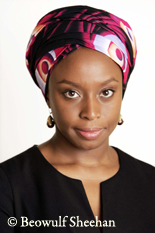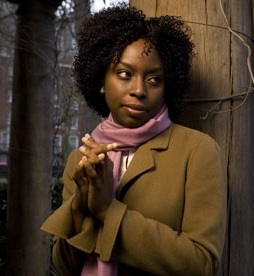
Who is Chimamanda
Ngozi Adichie?
She is a writer, she is the author of three
novels, Purple
Hibiscus(2003), Half of a Yellow Sun (2006), and Americanah(2013), of a short
story collection, The Thing
around Your Neck (2009).
She has received numerous awards and distinctions, including the Orange
Broadband Prize for Fiction (2007) and a MacArthur Foundation Fellowship
(2008).
Some interesting
facts about her life
Chimamanda Ngozi Adichie was born September 15, 1977
in Enugu, Nigeria. She was raised in Nsukka near the University of Nigeria. Her
father, James Nwoye Adichie, was a professor of statistics and later became the
Deputy Vice-Chancellor of the University. Her mother, Ifeoma Aidichie, became
the first female registrar at the University. Adichie is the fifth child in a
family of six children. She is of Igbo descent and her ancestral home is in
Abba.
Adichie was an A student who often butted heads with her teachers. Despite her
reputation, she received several academic awards. Adichie enrolled in medical
school at the behest of her father. She soon dropped out to pursue her dream of
becoming a writer. When she was 19, she left Nigeria on a scholarship to Drexel
University in Philadelphia. She studied communication at Drexel and earned a
degree in communication and political science at Eastern Connecticut State
University. She graduated summa cum laude in 2001. Later that year, she began
MFA courses in literature at Johns Hopkins University.
Adichie credits Chinua Achebe, Igbo author of Nigerian
masterwork “Things Fall Apart”, with
her literary success. She once lived in Achebe’s house and believes his halo
surrounded her. After reading his book at 10 years old, she realized that
people who looked like her could exist in books. Her desire to write was
sparked by his work.
In 2003, “Purple Hibiscus” was published to wide acclaim. It was shortlisted for
the Orange Prize and awarded the Commonwealth Writers’ Prize for Best First
Book. She was awarded with the Orange Prize in 2007 for her second novel, “Half of a Yellow Sun”, about the Biafran War. In 2008, she received a
MacArthur Fellowship. A collection of short stories, The Thing Around Your
Neck, was published in 2009.
Adichie tries to combat the image of Africans as
portrayed by Western media. Choosing to write first from her experience as an
affluent and educated Nigerian, she was often criticized for shying away from
the “real” Africa. But she struggled to write characters who were not
“starving, or begin bullied by [Zimbabwean dictator] Mugabe, or dying of AIDS.”
As reflected in her writing voice, Adichie is a staunch feminist and uses her
work as a way to work through the misogyny and condescension she has faced as
an African woman in the global literary community.
She splits her time between the Unites States and
Nigeria, married to a Maryland-based doctor. Her next novel will chronicle the
Nigerian immigrant experience in America.

Chimamanda
Ngozi Adichie's quotations
“To be humans is to want to be valued”
“Books are immensely powerful. A
power that often transcends the creator of the book himself.”
“Logic can convince us but it is in
fact emotions that lead us to act. We are emotional beings.”
“I write because I have to.”
“I love creating characters who
sometimes speak to me.”
“I love the possibility of touching
another human being with my work.”
“I think my writing is magical, it is
a whispering of the spirits, it is an inexplicable gift I had been blessed
with.”
“Literature is not just words.”
“We should read human stories not
only to be delighted but also to remain ourselves that we are not alone, that
we, in the words of Pablo Neruda, belong to this great mass of humanity, not to
the few, but to the many.”
It is an interesting intervew, in which Chimamanda talks about her books.
Here, there is another interview, in which she talks about her country and her feelings for it.
To visit her official website, please, click here.
I also found this site which provides interesting information about her life.
Sources:
Gradesaver, Biography of
Chimamanda Ngozi Adichie. Available at: http://www.gradesaver.com/author/chimamanda-ngozi-adichie/. Retrieved: May 15, 2013
Nairaland
Forum, Chimamanda
Adichie: 16 Things You Did Not Know About Her.
Available
at: http://www.nairaland.com/1154513/chimamanda-adichie-16-things-did. Retrieved: May 15, 2013
Youtube, Chimamanda Ngozi Adichie: Commonwealth lecture 2012. Available at: http://www.youtube.com/watch?feature=player_embedded&v=vmsYJDP8g2U. Retrieved: May 15, 2013
My paragraphs summarizing her arguments: paragraphs by listing and by examples
Chimamada Ngozi Adichie is a famous writer born in Nigeria, she not only
loves writing but also reading others writers’ books. For example, as a child,
she read ‘The Dark Child’ by Camara Laye, a book of startling beauty, defiant
optimism, and the most layered nostalgia. As another example, she also enjoyed Chinua
Achebe’s novels “Things Fall Apart” and “Arrow of God,” it was those kinds of novels
that made her realize that while she may very well know the facts, she did not
really know the truths. As still another instance, she fell in love with Sri
Lanka after she read Romesh Gunesekera’s beautiful novel, “Reef”, with its
evocation of friendship, love and politics in a country about to be torn apart by
war. Clearly, this writer takes pleasure in reading her colleagues’ works as
well as in expressing herself in her own books.
Chimamanda Adichie, a Nigerian writer,
confesses the fact that she wrote different kinds of writings throughout her
experience as a writer. Firstly, she affirms that when she was a child, at the
age of seven, she wrote the kind of stories that she had read. This meant that
she wrote stories about blue-eyed white children who played in the snow and ate
apples. Then, Adichie started believing that she had no place in books
since they did not represent her at all. This changed when she discovered
African writers such as Chinua Achebe and Camara Laye. She realized that books
could also tell the stories of people like her. Finally, she started
writing “realist literature” which, to her mind, transmits sensibility, both
for the reader and the writer. This kind of art represents real people in real
situations, in real places. Clearly, some particular facts in her personal life
made her change her style of writing.


No hay comentarios:
Publicar un comentario